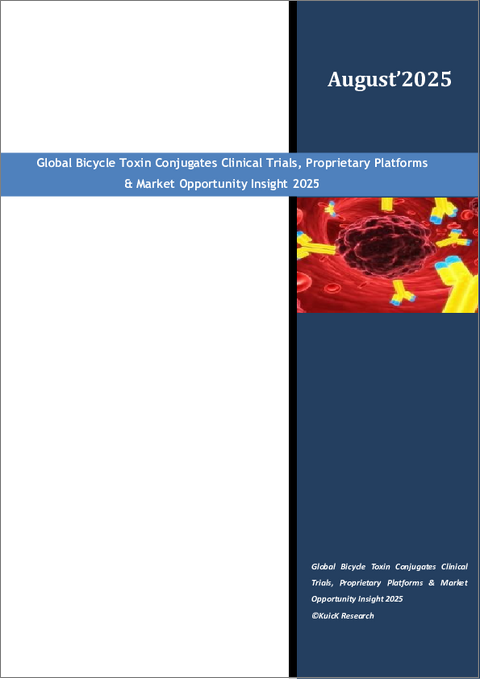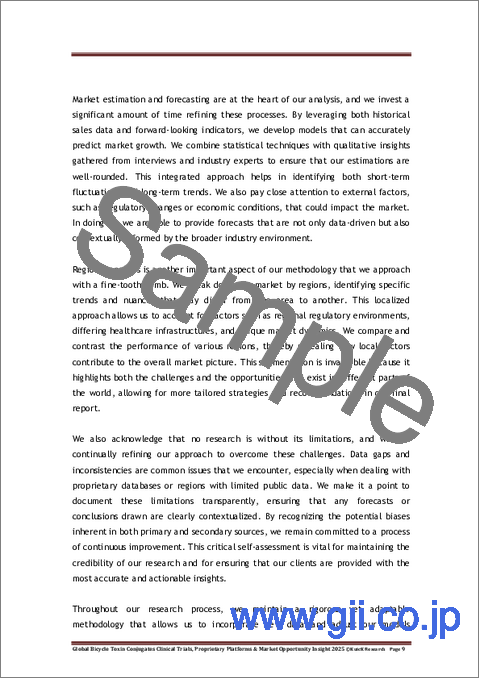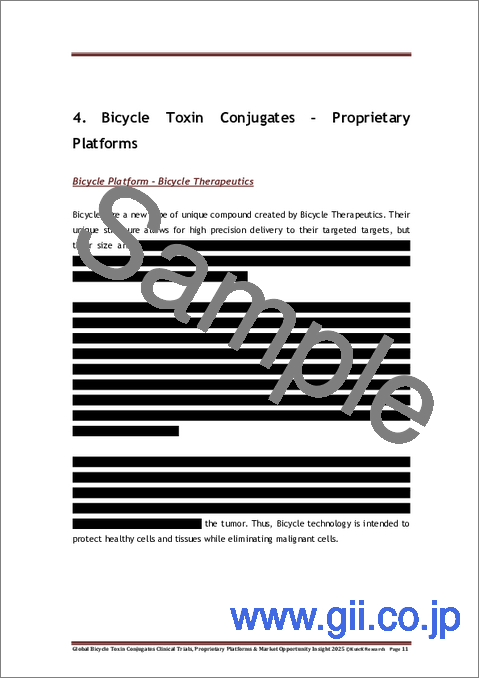|
|
市場調査レポート
商品コード
1799230
バイシクルトキシンコンジュゲートの世界市場 - 臨床試験、独自プラットフォーム、市場の機会(2025年)Global Bicycle Toxin Conjugates Clinical Trials, Proprietary Platforms & Market Opportunity Insight 2025 |
||||||
|
|||||||
| バイシクルトキシンコンジュゲートの世界市場 - 臨床試験、独自プラットフォーム、市場の機会(2025年) |
|
出版日: 2025年08月01日
発行: KuicK Research
ページ情報: 英文 55 Pages
納期: 即日から翌営業日
|
全表示
- 概要
- 図表
- 目次
バイシクルトキシンコンジュゲートの世界市場 - 臨床試験、独自プラットフォーム、市場の機会(2025年)レポートのハイライト
- 世界の動向と地域動向の洞察
- バイシクルトキシンコンジュゲート独自プラットフォームの概要
- バイシクルトキシンコンジュゲートの研究、適応症別市場動向
- 二環系毒素コンジュゲートの企業別、適応症別、相別の臨床パイプライン
- 今後の商業化の機会
- 競合情勢
バイシクルトキシンコンジュゲートの必要性と当レポートの意義
より安全で、より効果的で、標的性の高い抗がん剤治療に対するニーズの高まりが、新たな治療法へ向けた創薬の原動力となっています。バイシクルトキシンコンジュゲート(BTC)は新世代の標的治療薬であり、精度の高さ、良好な薬物動態、腫瘍への浸透性などを特徴としています。二環式ペプチドの結合親和性と化学療法薬の細胞毒性ペイロードを組み合わせることにより、BTCは全身毒性を抑えながら非常に効果的な抗がん活性を発揮するように設計されています。
この報告は、バイシクルトキシンコンジュゲートの領域が、初期の臨床的有望性から確かな成果へと移行する中で、タイムリーかつ重要なものです。この領域はまだ黎明期ではあるが、臨床の進展、規制当局の承認、研究投資の速度は増しています。本分析は、バイシクルトキシンコンジュゲートが科学的、臨床的、商業的に現在どの段階にあるかを包括的に展望し、利害関係者に、腫瘍学およびそれ以降の将来のベンチマークを再編成する可能性のある、急速に発展している領域に関する重要な洞察を提供します。
レポートに含まれる臨床試験に関する洞察
当レポートでは、現在進行中のバイシクルトキシンコンジュゲート臨床試験の状況を詳細にサマリーし、初期および中期段階における主要な治療薬候補の開発について概説しています。Bicycle Therapeuticsが創製した3つの自転車毒素コンジュゲート、すなわちBT1718、BT5528、zelenectide pevedotin(Zele、BT8009)は、初期および後期の臨床試験で研究されています。これらの臨床試験は、さまざまな固形がんにおいて、いくつかの腫瘍関連抗原、MT1-MMP、EphA2、Nectin-4に対するものです。
当レポートでは、臨床試験の相、地域、スポンサー団体、研究中の適応症など、これらの臨床試験に関する注目すべき情報を記録しています。また、現在までの主な試験結果もまとめています。このデータは、バイシクルトキシンコンジュゲートの臨床経過と規制上の有望性を明確かつ正確に示すものです。
技術プラットフォーム、共同研究、契約
Bicycle Therapeutics独自のBicycle(R)プラットフォームは、バイシクルトキシンコンジュゲート開発の技術的基盤を構成しています。化学的に合成されたペプチド技術により、MMAEやDM1などの細胞毒素と結合した小型で選択性の高い結合剤を生成することができます。この結果、生物学的製剤と低分子の中間的な治療薬クラスが生まれ、腫瘍深部への浸透が強化され、クリアランスが促進されます。
協同作用は当社のアプローチの中核です。英国がん研究協会(Cancer Research UK)との新たな共同研究により、BT1718は第1/2相臨床試験に移行し、英国がん研究協会(Cancer Research UK)が臨床試験のスポンサーとなり資金を提供しています。さらに、FDAのCMC開発準備試験(CDRP)にも参加しています。
バイシクルトキシンコンジュゲートの研究開発に積極的な主要企業
現在、Bicycle Therapeuticsは、バイシクルトキシンコンジュゲートの臨床段階に積極的に取り組んでいる唯一の企業です。英国ケンブリッジに設立されたBicycle Therapeuticsは、様々な腫瘍に対応するバイシクルトキシンコンジュゲートのポートフォリオを有するこの分野の世界的リーダーです。同社が第一世代、第二世代、第三世代の自転車毒素コンジュゲートの開発を続けているのは、この新しいクラスの治療法の進歩に注力していることを反映しています。Bicycle Therapeuticsは、世界の臨床試験と両大西洋における規制当局とのやり取りを通じて、バイシクルトキシンコンジュゲートの今後の方向性と可能性を世界的に明らかにしています。
バイシクルトキシンコンジュゲートセグメントの今後の方向性を示唆するレポート
当レポートでは、バイシクルトキシンコンジュゲートが、プレシジョン・オンコロジーにおいて不可欠な新進気鋭のカテゴリーであり、適応症によってはADCに匹敵する、あるいはADCを凌駕する可能性があることを明らかにしています。ファスト・トラックやCDRP指定などの規制上の関心は、バイシクルトキシンコンジュゲートに対する医療機関の関心の高まりを反映しています。併用療法における臨床的有効性は、バイシクルトキシンコンジュゲートが短期間のうちに第一線のがん治療レジメンの不可欠な一部となる可能性を示唆しています。
開発が進めば、バイシクルトキシンコンジュゲートプラットフォームは腫瘍学以外でも利用できるようになり、感染症や、標的ペイロードの送達を必要とするその他の適応症でも有望視されます。ここに示したバイシクルトキシンコンジュゲート分野の開発は、規制当局に受け入れられ、応用が拡大し、産業界に浸透していく道筋を明確に示しています。
目次
第1章 バイシクルトキシンコンジュゲートのイントロダクション
- 概要
- 歴史と進化
第2章 バイシクルトキシンコンジュゲート- 作用機序
第3章 世界のバイシクルトキシンコンジュゲートの調査と市場動向(適応症別)
- がん
- ウイルス性疾患
第4章 バイシクルトキシンコンジュゲート- 独自のプラットフォーム
第5章 二環式毒素複合体の臨床試験の概要
- 企業別
- 適応症別
- 場所別
- 相別
第6章 企業、適応症、相別の世界の二環式毒素複合体の臨床パイプライン
- 第I/II相
- 第III相
第7章 世界のバイシクルトキシンコンジュゲートの現在および将来の市場動向と展望
- 現在の市場動向、開発、臨床試験の評価
- 将来の商業化の機会
第8章 世界のバイシクルトキシンコンジュゲートの研究と地域別市場動向
- 米国
- 欧州連合
- 英国
第9章 世界のバイシクルトキシンコンジュゲート市場力学
- 市場促進要因と商業機会
- 市場の課題と抑制要因
第10章 競合情勢
- Bicycle Therapeutics
List of Figures
- Figure 1-1: Bicycle Toxin Conjugate - Structure
- Figure 2-1: Bicycle Toxin Conjugates - Mechanism Of Action
- Figure 3-1: Zelenectide Pevedotin - Structure
- Figure 3-2: Duravelo-1 Phase 1/2 (NCT04561362) Study - Initiation & Completion Year
- Figure 3-3: Duravelo-2 Phase 2/3 (NCT06225596) Study - Initiation & Completion Year
- Figure 3-4: Duravelo-3 Phase 2 (NCT06840483) Study - Initiation & Completion Year
- Figure 3-5: Duravelo-4 Phase 2 (NCT06933329) Study - Initiation & Completion Year
- Figure 3-6: BT5528 - Structure
- Figure 3-7: BT5528-100 Phase 1/2 Study - Initiation & Completion Year
- Figure 3-8: BT1718 - Structure
- Figure 4-1: Bicycles - Advantages
- Figure 4-2: Bicycles - Key Properties
- Figure 5-1: Global - Bicyclic Toxin Conjugates Clinical Trials By Company (Number), 2025
- Figure 5-2: Global - Bicyclic Toxin Conjugates Clinical Trials By Indication (Number), 2025
- Figure 5-3: Global - Bicyclic Toxin Conjugates Clinical Trials By Location (Number), 2025
- Figure 5-4: Global - Bicyclic Toxin Conjugates Clinical Trials By Phase (Number), 2025
- Figure 7-1: Global Bicycle Toxin Conjugates Market - Future Opportunities
- Figure 9-1: Bicycle Toxin Conjugates Market - Drivers & Opportunities
- Figure 9-2: Bicycle Toxin Conjugates Market - Challenges & Restraints
List of Tables
- Table 8-1: US - Ongoing Clinical Trials for Bicycle Toxin Conjugates
- Table 8-2: EU - Ongoing Clinical Trials for Bicycle Toxin Conjugates
- Table 8-3: UK - Ongoing Clinical Trials for Bicycle Toxin Conjugates
Global Bicycle Toxin Conjugates Clinical Trials, Proprietary Platforms & Market Opportunity Insight 2025 Report Highlights:
- Global & Regional Trends Insight
- Bicycle Toxin Conjugates Proprietary Platforms Overview
- Bicycle Toxin Conjugates Research & Market Trends By Indication
- Bicyclic Toxin Conjugates Clinical Pipeline By Company, Indication & Phase
- Future Commercialization Opportunity
- Competitive Landscape
Need for Bicycle Toxin Conjugates & Why This Report?
The increasing need for safer, more effective, and highly targeted anticancer therapies has driven pharmaceutical discovery towards new therapeutic modalities. Bicycle Toxin Conjugates (BTCs) are a new generation of targeted therapies possessing a distinctive blend of precision, favorable pharmacokinetics, and tumor penetration. Combining the binding affinity of bicyclic peptides and the cytotoxic payloads of chemotherapy drugs, BTCs are engineered to provide highly effective anti-cancer activity with reduced systemic toxicity.
This report is timely and critical as the bicycle toxin conjugates space transitions from initial clinical promise to solid achievements. While the area remains in its infancy, the velocity of clinical advancement, regulatory acceptance, and research investment is increasing. This analysis provides an all-encompassing perspective on where bicycle toxin conjugates are scientifically, clinically, and commercially now and gives stakeholders critical insight into a fast-developing area that can reshape future benchmarks in oncology and beyond.
Clinical Trials Insight Included In Report
The report offers an in-depth summary of the ongoing bicycle toxin conjugates clinical trial landscape, outlining the development of major therapeutic candidates through early- and mid-stage studies. Three bicycle toxin conjugates created by Bicycle Therapeutics, namely BT1718, BT5528, and zelenectide pevedotin (Zele, BT8009), are being studied in early and late-stage clinical trials. These trials are directed against several tumor-associated antigens, MT1-MMP, EphA2, and Nectin-4, in a variety of solid tumors.
This report records notable information on these trials, such as trial phases, geographical regions, sponsoring organizations, and indications being researched. It also summarizes key trial results to date; this data offer a clear, precise view of bicycle toxin conjugates clinical progress and regulatory promise
Technology Platforms, Collaborations and Agreements
Bicycle Therapeutics' proprietary Bicycle(R) platform constitutes the technological underpinning of bicycle toxin conjugates development. The chemically synthesized peptide technology allows small, highly selective binding agents to be generated coupled with cytotoxins such as MMAE and DM1. This results in a class of therapies that are intermediate between biologics and small molecules, showing enhanced deep tumor penetration and accelerated clearance.
Cooperative action is at the core of the firm's approach. A new collaboration with Cancer Research UK has brought BT1718 to Phase 1/2 trials, with CRUK sponsoring and funding the trial. Furthermore, the firm's engagement in the FDA's CMC Development and Readiness Pilot (CDRP).
Major Companies Active In R&D of Bicycle-Toxin Conjugates
Currently, Bicycle Therapeutics is the only company actively working on bicycle toxin conjugates at a clinical stage. Established in Cambridge, UK, the company is the global leader in this area with a portfolio of bicycle toxin conjugates addressing a variety of tumors. Its continued development of first-, second-, and third-generation bicycle toxin conjugates reflects its focus on advancing this new class of therapy. Through global trials and regulatory interaction on both Atlantic sides, Bicycle Therapeutics is outlining the future direction and potential of bicycle toxin conjugates worldwide.
Report Suggesting Future Direction Of Bicycle-Toxin Conjugates Segment
This report identifies bicycle toxin conjugates as an essential up-and-coming category in precision oncology with the potential to either match or even outperform ADCs in some indications. Regulatory interest, including Fast Track and CDRP designation, reflects increasing institutional interest in bicycle toxin conjugates. Clinical efficacy in combination therapies implies bicycle toxin conjugates may become an integral part of front-line cancer regimens within a short while.
As it continues to develop, the bicycle toxin conjugates platform can also be utilized outside of oncology, with promise in infectious disease and other indications that call for targeted payload delivery. The development of the bicycle toxin conjugates segment, as illustrated here, clearly shows a path toward regulatory acceptance, expanded application, and increased industry uptake.
Table of Contents
1. Introduction To Bicycle Toxin Conjugates
- 1.1 Overview
- 1.2 History & Evolution
2. Bicycle Toxin Conjugates - Mechanism Of Action
3. Global Bicycle Toxin Conjugates Research & Market Trends By Indication
- 3.1 Cancer
- 3.2 Viral Diseases
4. Bicycle Toxin Conjugates - Proprietary Platforms
5. Global Bicyclic Toxin Conjugates Clinical Trials Overview
- 5.1 By Company
- 5.2 By Indication
- 5.3 By Location
- 5.4 By Phase
6. Global Bicyclic Toxin Conjugates Clinical Pipeline By Company, Indication & Phase
- 6.1 Phase-I/II
- 6.2 Phase-III
7. Global Bicycle Toxin Conjugates Current & Future Market Trends Outlook
- 7.1 Current Market Trends, Developments & Clinical Trials Assessment
- 7.2 Future Commercialization Opportunity
8. Global Bicycle Toxin Conjugates Research & Market Trends By Region
- 8.1 US
- 8.2 EU
- 8.3 UK
9. Global Bicycle Toxin Conjugates Market Dynamics
- 9.1 Market Drivers & Commercial Opportunities
- 9.2 Market Challenges & Restraints
10. Competitive Landscape
- 10.1 Bicycle Therapeutics






